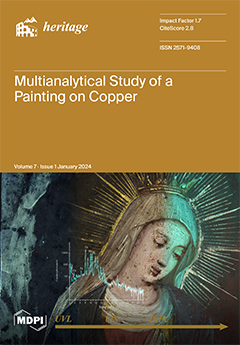This pioneering work studied the medieval color palette of four manuscripts produced in the scriptorium of Alfonso X, king of the Crown of Castile (r. 1252-84), including the
Songs of Holy Mary (Cantigas de Santa Maria, in Rich Codex and Musicians’ Codex),
Lapidary
[...] Read more.
This pioneering work studied the medieval color palette of four manuscripts produced in the scriptorium of Alfonso X, king of the Crown of Castile (r. 1252-84), including the
Songs of Holy Mary (Cantigas de Santa Maria, in Rich Codex and Musicians’ Codex),
Lapidary (Lapidario), and
Book of Games (Libro de los juegos). Scientific analysis based on fiber-optics reflectance spectroscopy in the visible and Raman spectroscopy showed a color palette based on lapis lazuli, indigo, azurite, vermilion, red lead, orpiment, yellow ochre, two different greens (bottle green and
vergaut), lead white, carbon-based black, and most importantly, brazilwood pinks, reds, and purples. So, it is now the first reported use of this lake pigment in European medieval manuscript illumination. The painting technique is also discussed. The diversity of colors and techniques, with the presence of lapis lazuli, brazilwood lake pigments, purple, and gold, demonstrates Alfonso X’s desire to produce sumptuous manuscripts.
Full article





